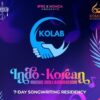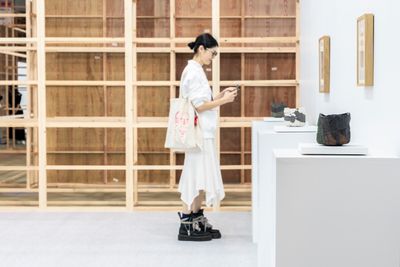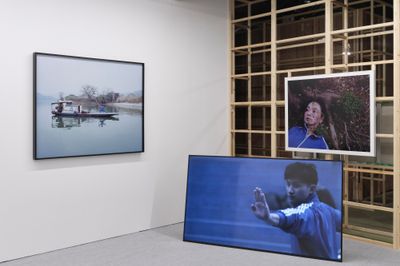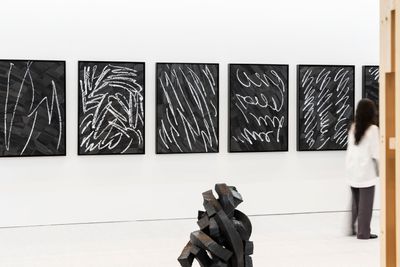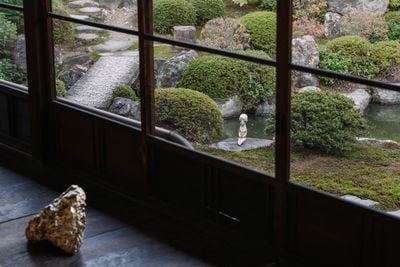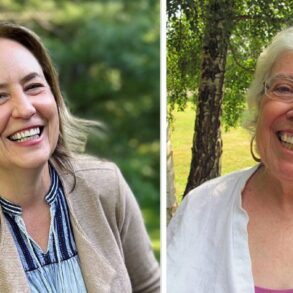In its fourth year, the fair deepened its roots with stunning site-specific events across the city and widened its reach with stronger international engagement.

Art Collaboration Kyoto, 2024. Courtesy ACK. Photo: Yuki Moriya.
Kyoto has been a cultural wellspring for millennia, so it makes sense for Art Collaboration Kyoto (ACK) to take the long view. The theme for its fourth edition, held 1–3 November, was ‘Resilience: For Your Own Happiness’. As Programme Director Yukako Yamashita explained, the emphasis on collaboration stems from a desire to ‘create something for the future’.
Kyoto governor Takatoshi Nishiwaki echoed this sentiment at an onsite talk during the preview on 31 October, noting that while Japan’s art market remains small compared to its GDP, Kyoto’s public and private sectors understand the need for cooperation to ‘create a city that will resonate with artists and curators’. One product of this commitment is ACK, which successfully weathered the pandemic to become a rising star on the global art fair circuit.
Mitochu Koeki Co.-Annely Juda Fine Art, 2024. Courtesy of ACK. Photo: Yuki Moriya.
The premise of ACK remains unchanged: Japanese hosts chosen by a multinational selection committee of gallery directors invite participants from outside Japan to share a booth in the fair’s main section, called ‘Gallery Collaborations’.
While this year’s ACK was the largest yet, featuring 69 galleries from 24 cities, it remains modest in size compared to other international fairs. There were 33 first-time exhibitors, with a swell in applications from aspiring participants, while a number of galleries and cities that lent the fair energy in its first years were conspicuously absent. Organisers stressed quality and diversity as the top objectives for gallery selection, but did not elaborate on how they define these criteria.
ACK Venue, 2024, with a view of the Matthew Marks Gallery and Taro Nasu booth. Courtesy of ACK. Photo: Yuki Moriya.
Kyoto International Conference Center in the northern part of the city hosted ACK again this year, with the spatial design revamped by architect Takashi Suo. The layout, inspired by Kyoto’s intricate maze of alleys, incorporated wooden frames constructed from recycled shipping crates used by art museums. Shelf-like attachments on the scaffolding allowed for playful displays.
New York‘s Matthew Marks Gallery and Tokyo‘s Taro Nasu, for instance, cheekily installed on the outer ledge of their booth Robert Gober‘s Short Haired Cheese (1992–1993), a yellowish wedge of beeswax that seemed to have undergone follicle transplant surgery.
Chen Quinlin, Peppermint (2018). Film photography and single-channel HD video. Photo: Jinhyeok Oh.
Several participants remarked that ACK has steadily become more international in both its galleries and visitors. This was exemplified by a tri-continental booth comprising Crèvecœur (Paris), Mujin-To Production (Tokyo), and Nonaka-Hill (Los Angeles), the last opening a new Kyoto space the same week with an inaugural show by Ulala Imai. Crèvecœur‘s director Axel Dibie, a selection committee member, told Ocula that while sales had been strong for his gallery, which presented artists including the genre-bending Louise Sartor, what he appreciated most about ACK was the opportunity for meaningful engagement with people from various corners of the art world.
East Asia’s contemporary art scene was well-represented with a collaboration by Anomaly (Tokyo), N/A (Seoul), and A Thousand Plateaus Art Space (Chengdu). Anomaly showed intricate sculptures made of everyday materials by Takahiro Iwasaki; N/A offered the frenetic graphite and oil pastel paintings of Jeman Seo; and A Thousand Plateaus exhibited Chen Quinlin’s photography, video and sculpture series Peppermint (2018), an elegiac exploration of ‘memory, loss and resilience’ through the lens of her childhood martial arts group and lost hometown, a place submerged by dam-building.
Tseng Chien-Ying, Bromance (2024). Two-panel screen, ink and colours on paper, mineral pigments, 132 x 137 cm. Courtesy Each Modern.
Each Modern (Taipei) partnered with Tomio Koyama Gallery (Tokyo) and sold several paintings and sculptures in the range of ¥400,000 to ¥3.5 million (U.S. $2,633–23,040) by Tseng Chien-Ying, whose peach-shaped work Bromance (2024) depicts the Zen duo Hanshan and Shide as a combination of Asian art traditions with erotic undertones. Charwei Tsai, featured at the booth for TKG+ (Taipei) and ShugoArts (Tokyo), also drew from cultural classics in her series of gleaming celadon ceramics inscribed with the Heart Sutra.
Johyun Gallery, 2024. Courtesy of ACK. Photo: Yuki Moriya.
Artists with ties to the host city are spotlighted in the ‘Kyoto Meetings’ section. Standouts this year included Johyun Gallery (Busan), which presented three major Korean contemporary artists influenced by Japan’s ancient capital. Park Seo-Bo’s painting Ecriture No.130417 (2013), inspired by the brilliant vermilion of Kyoto’s autumn foliage, attracted one of the fair’s highest reported selling prices at U.S. $450,000–$500,000.
Sales reports from the floor were mixed, with some galleries citing a generally sluggish market and competing events in Tokyo as headwinds. Others, including Kyoto’s Kanegae, Sao Paulo‘s Mendes Wood DM, and Tokyo’s Maho Kubota Gallery celebrated sold-out artists and shows. Blum described its sales as ‘slow’ on opening day but had placed works including a painting by Ryan Sullivan for U.S. $55,000 by the end of the fair. Total sales for this year have not yet been announced, but they held steady in 2022 and 2023 at around JPY ¥400 million (U.S. $2.6 million).
Installation view at Ryosokuin Zen Temple, Kyoto, Japan. Photo: Mitsuru Wakabayashi. Courtesy of Executive Committee, 黙: Speaking in Silence Exhibition. ©︎2024 Bosco Sodi, © 2024 Izumi Kato.
ACK’s greatest strength may be the city of Kyoto itself, where it has nurtured a full programme of off-site exhibitions at local temples and galleries. At Zuiho-in, part of the Daitokuji Temple complex, Tokyo’s t.gallery incorporated works by six exceptional Japanese contemporary artists including the colourful and eclectic works of avant-garde ceramicist Takuro Kuwata in a landscape-themed show that resonated with the site’s architecture, fusuma-e ink paintings on sliding doors, and the rock garden designed by master landscape architect Mirei Shigemori.
Installation view: Andreas Eriksson, Rakuyou, Murin-an, Kyoto, 31 October–3 November, 2024. © Andreas Eriksson. Courtesy the artist and neugerriemschneider, Berlin. Photo: Yuki Moriya.
This harmony of environment and art could be seen in other ACK-affiliated shows as well. Among them were 黙: Speaking in Silence co-curated by long-time friends Izumi Kato (Perrotin) and Bosco Sodi (Scai The Bathhouse) at Ryosokuin Zen Temple, and Rakuyou by neugerriemschneider of Berlin, which exhibited the softly hued ‘psychological landscapes’ of Swedish painter Andreas Eriksson in Japan for the first time at Nanzenji Temple’s Murin-an villa.
Art Collaboration Kyoto will return 14–16 November, 2025. —[O]



